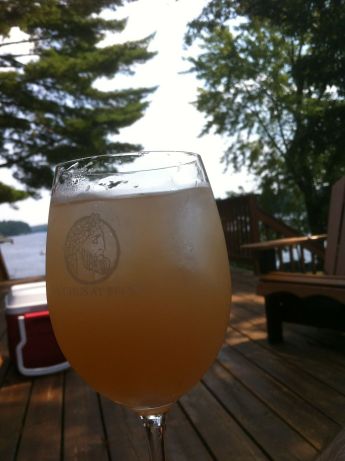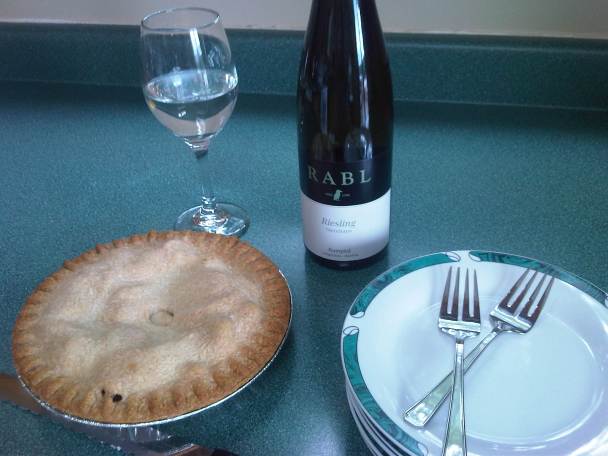Oz Clarke dishes the dirt — minerality? — about Riesling with Matt Kramer and Kevin Zraly. Feel the love.

Tom Who? The Dave Frederics is a refreshing blend of Riesling, ruby grapefruit juice and ginger ale.
Although there were many well-known personalities at last week’s 2012 InterVin International Wine Awards, the star of the show proved to be Dave Frederics, a Riesling-based cocktail.
Like its namesake, the origins of the Dave Frederics cocktail are cloaked in mystery. At first, many were leery to try the fresh, fruity concoction — the spectre of poorly made white wine spritzers had left a bad taste in many people’s mouths. But tasting is believing. By the end of the night, winemakers, wine writers and sommeliers alike could be heard at the bar saying things like “Hit me with another Dave!”
Colourful, delicious and very refreshing, the Dave Frederics was embraced as the official cocktail of InterVin and was quickly added to the cocktail menu at Treadwell Farm to Table Cuisine in Port Dalhousie.
You can see what all of the fuss is about by making your own. Mix 2 parts Riesling (preferably from the Niagara Peninsula), 1 part ruby Ruby Grapefruit Juice and 1 part diet ginger ale (regular ginger ale also works) in a wine glass filled with ice. Garnish with an orange or grapefruit slice and enjoy!
It should be obvious by this point that we have a major thang for Riesling. Don’t get us wrong, we love other selections too — Riesling just happens to be the wine of summer! To prove our appreciation, we want to share this fantastic white blend, which just so happens to have Riesling in it.
Bodegas Amalaya 2011 Torontes-Riesling (Calchaqui Valley, Argentina $10.95, 270470) is a well-priced Argentinian wine which offers a bouquet of floral, apricot and juicy apple notes with a hint of cinnamon. On the palate, the racy wine showcases mineral, lime and melon. Its lingering pear finish will make you crave strong cheeses or white fish.
So to sum up? We love our Rieslings sparkling, sweet, dry, with food or, even, in a blend. We just can’t get enough.
Working at a tasting bar, you learn the tricks of the trade: What makes peoples mouth water. What heightens their experience. And, what makes them buy wine. I quickly discovered that the average customer is looking for wines that are easy to appreciate and understandable. They are not necessarily looking for complexity, but rather for characteristics they can identify.
Ontario Riesling is easy to enjoy because it is fresh, fruity and less intimidating than oaked Chardonnays or complex Pinot Noirs. Whenever someone told me they liked Riesling, I was delighted because it made my job easier. I didn’t have to worry about convincing customers that they liked the wine or confusing them with wine-speak. The wine always sold itself.
Having something people can relate to makes it more approachable — that’s a big part of Riesling’s charm. Not only is it honest and truthful, it’s relatable and easy to love. I mean, who can resist the refreshing characteristics of apples and peaches? Certainly not me. ANDREA FUJARCZUK
The Alsace region is known for its intricate white wines and because of its close proximity to Germany, it has strong German influences. They produce similar grapes and also label them by the varietal (which most of France does not do) but where Germany is known for its sweet Rieslings, Alsace typically adopts a much drier style.
Lucien Albrecht 2009 Cuveé Henri Albrecht Riesling (Alsace, 23.95, 281402) is a delicious dry white, which is a great representation of its picturesque border town. It is a well-integrated Riesling created with copious amounts of intriguing layered flavours.
Delicate aromas of pear, apple, spice and honey and flavours of melon, mineral notes, nuttiness and smoke come together in this complex wine. The long finish of nutmeg rounds out the racy Riesling. Offer this white to your red wine loving friends, it might be the bottle that has just enough substance to open their eyes to new options.
Tempura is a light and crunchy Japanese batter that can cover almost anything and make it taste delicious. Often vegetables like sweet potato or bell pepper or seafood such as shrimp are covered in tempura batter and fried, all which pair beautifully with Riesling. When I asked a friend how to make tempura at home she explained, depending on how you want your batter to turn out, there are two ways of making tempura batter:
1. If you want to achieve a flat and crunchy batter like a croquette, coat shrimp in flour, dip in beaten egg, then coat with panko crumbs. Deep-fry until browned.
2. To recreate a restaurant-style light and crunchy batter, beat an egg in a bowl, add ice cold water and flour into the bowl and mix gently. Make sure the batter stays cold as the crunchiness comes from the temperature difference between the batter and oil. (Proportions are approximately one egg, one cup water, one cup flour) Dip shrimp into batter and fry.
Panko crumbs can be purchased at any grocery store with an Asian section.
Tempura is easy to make and a great way to add satisfaction to any meal. ANUPA SIMON
Riesling is a source of endless fascination because the wines of this grape precisely reflect where they grew and who made them, making them more diverse than those of any other white wine grape.
Stuart Pigott, British wine critic

Label Language: Germany’s exacting classification system helps you select wines with the sweetness level you prefer
Choosing a sweet wine can be like selecting toppings on a burger. If you were given a delicious burger with the wrong toppings, you probably wouldn’t like it. Botrytis affected wines are delicious, but following suit with burger toppings, you have to discover what style of sweetness best suits you.
Germany has its own type of classification scheme that might help you decide what type of botrytis affected Riesling tickles your fancy.
Trockenbeerenauslese (TBA), or dried berry selection, is an intensely sweet wine made from entirely botrytis affected grapes, with each grape having been picked individually. It is rare to find — often incredibly expensive — and is a great alternative to dessert.
Beerenauslese (BA), or selected of harvest berries, is similar to TBA, where the berries are picked individually and, although very sweet, is not as sweet as TBA wines created mainly from botrytis affected bunches.
Auslese is on the sweeter side but is not as sweet as Beerenauslese or Trockenbeerenauslese. It is from hand harvested grapes which may have a portion of the wines being botrytis affected.






